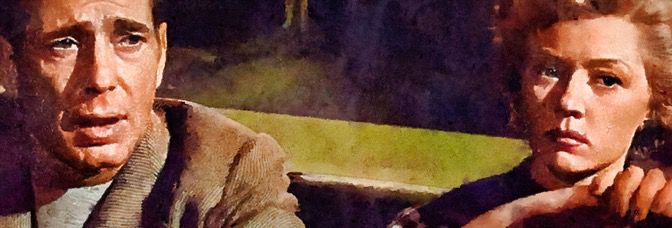Watching the opening titles of In a Lonely Place, I wished the design had allowed for it to appear like it was saying “Humphrey Bogart in A Lonely Place.” Just because. But it doesn’t. And wouldn’t really be appropriate either as it’s unclear, some ninety minutes later, if Bogart was indeed in a lonely place. There are hints at it, including singer Hadda Brooks’s number. But how much does Bogart’s life and demeanor change once romantic interest (and second and third act lead) Gloria Grahame enter his life? Not clear. He’s more productive at work—Bogart’s a screenwriter; Lonely Place is a Hollywood story, though it ends up not really mattering. None of the details end up mattering much in Lonely Place. One of the film’s more lacerating issues.
To get the other more lacerating issue out of the way early on (saving director Ray’s indifference to supporting performances)—cinematographer Burnett Guffey. Lonely Place looks very much to be on a budget. Limited locations, limited cast, definite but inexpensive location shooting; the only thing Guffey shoots well is the exteriors. Otherwise, it’s flat lighting. Ray lets George Antheil’s music do all the emoting, even though the lighting could do just as much if not more. Antheil’s music gets a little much, but it’s fine because it’s got to do all the drama—see, what if it turns out Bogart’s not just an alcoholic, violent, egomaniac, but what if he’s also a killer. What if Grahame’s life’s in danger (even though Bogart’s apparently never functioned as well with her literally managing his life)? Grahame’s suspicions take a while; Lonely Place—even at ninety minutes—has a draggy second act. Once she gets them, the movie gets going for a bit, including bringing Jeff Donnell back into the movie because Grahame needs someone to share her fears with. Donnell’s great. She’s Frank Lovejoy’s wife. Lovejoy’s the copper investigating Bogart who knows him from during the war, when Bogart was his awesome CO. And presumably killed a lot of Germans with his bare hands and probably some rocks because, wow, does Bogart like getting in fights.
Carl Benton Reid is Lovejoy’s boss and he thinks Bogart’s good for the murder. He sees through the war hero bit; actually, only Lovejoy fawns over Bogart for it. Everyone else sort of things he maybe is a killer.
Even his agent, Art Smith. Smith’s likable but not very good. He and Robert Warwick (as a now drunken silent film star pal of Bogart’s) are the supporting actors whose performances Ray doesn’t care about. Occasionally they have really bad comedic moments, which might add to Lonely Place’s plodding. I can’t exactly remember because I wanted to forget them; the timing’s all off from Ray, leaving the actors with eggy faces.
Warwick’s similarly likable, except then it turns out he’s a pig.
Morris Ankrum is great as Bogart’s next project’s director. Shame he’s only in two scenes. He pushes back against Bogart, which the film needs. It’s not a good enough part for Bogart to take up all the air, which is why it’s so nice—and the film improves so much—when Grahame takes over the lead.
Andrew Solt’s screenplay (of Edmund H. North’s adaptation of Dorothy B. Hughes’s novel) doesn’t balance its leads well. When Bogart’s the lead in the first act, Grahame’s material is wanting. When Grahame’s the lead in the second and third acts… Bogart’s material is wanting. It’s too bad. But seems like a surmountable problem, only for the film’s deflated, predictable finish to take a safer route.
All the movie about the killer screenwriter needed was a… better screenwriter.
And cinematographer.
And for Ray to care equally about his actors’ performances. Speaking of which, I forgot to mention Martha Stewart. Better just leave it.
But Lonely Place does give Grahame a rather solid part for most of the movie. It even hints maybe she’s in the lonely place, only not really because she only gets a trouble sleeping scene to herself. Because problems. So many problems.
This post is part of the Noirathon hosted by Maddy of Maddy Loves Her Classic Films.


Leave a Reply